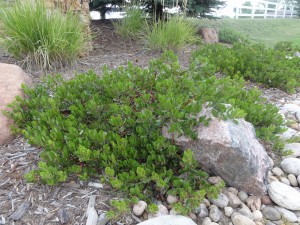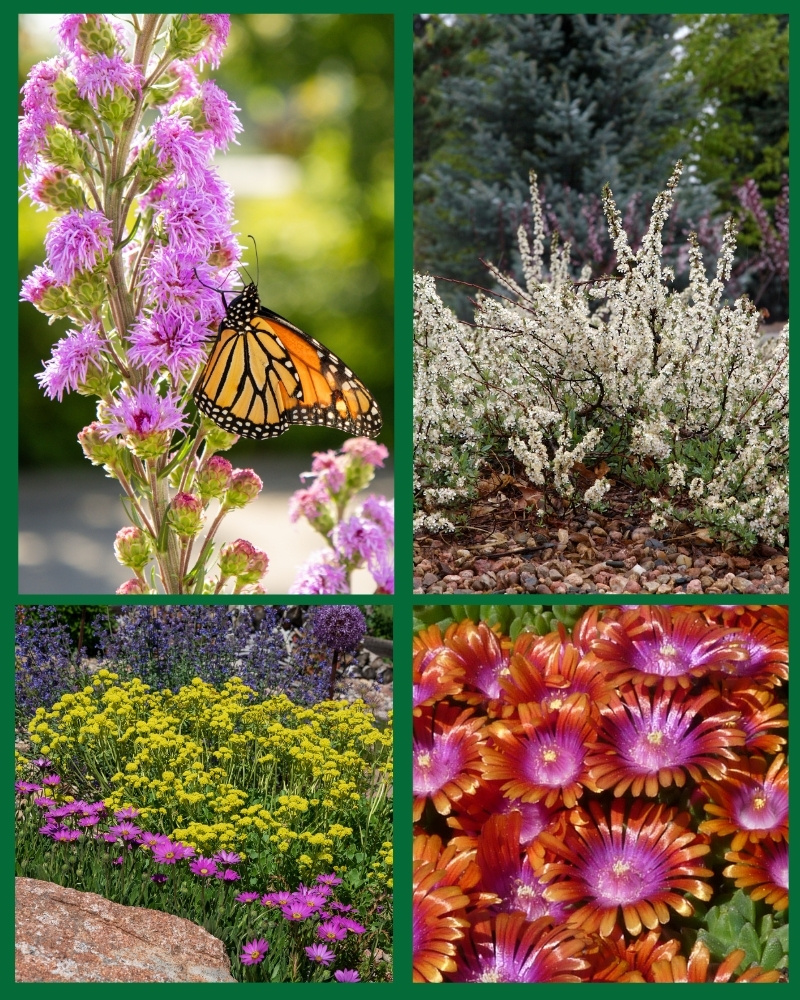The Manzanita Leader: Chieftain Manzanita
 Chieftain manzanitas (Arctostaphylos x coloradensis ‘Chieftain’) add a beautiful structural element to landscapes and introduce a more natural look to our man-made urban environments. Plant them around large pine trees, over retaining walls and as foundation plantings around homes and businesses.
Chieftain manzanitas (Arctostaphylos x coloradensis ‘Chieftain’) add a beautiful structural element to landscapes and introduce a more natural look to our man-made urban environments. Plant them around large pine trees, over retaining walls and as foundation plantings around homes and businesses.
The green, rounded leaves last all year, including through the winter! These shrubs grow to a mature height of around two feet tall.
This plant is believed to be a cross between the groundcover kinnikinnick (Arctostaphylos uva-ursi) and the bushier growing Arctostaphylos nevadensis.
These shrubs prefer a well-drained soil, so be sure to amend the soil to increase drainage when planting this gem in the urban environment. A few handfuls of sand in an oversized planting hole will do for each two gallon container planted. Water them regularly for a few years (like you would other woody shrubs). As they establish, you will notice that the Chieftain requires reduced watering and even flourishes in low water conditions. Be prepared to exercise your patience for a few years. Once it’s established, it can expand and thrive. (Even manzanita growers needed patience to bring mass quantities of this plant to market. Decoding consistent propagation techniques took some time!)
Plant maintenance is minimal to none. Prune the occasional branch for the simple reason of redirecting growth. For those who are meticulous about garden cleanliness, the mature height of 2 plus feet make this broadleaf evergreen easy to clean out using a small blower.
Chieftain is a texture plant. You’ll appreciate its other characteristics when you get up close and personal with it. For example, the smooth reddish-caramel bark and petite, pink flowers that emerge in April will tantalize your taste for these plants all year.
View the plant profile here or watch the video here.
Chieftain manzanita (Arctostaphylos x coloradensis ‘Chieftain’ )
Evergreen groundcover
Height: 18-24+”
Width: 5-8’
Blooms: April
Sun: Full sun to partial shade
Water: Moderate to xeric, once established
Hardiness: USDA zones 5-8
Culture: Well-drained loam or sandy soil
Thanks to Ross Shrigley for writing this piece.



Is Chieftain manzanita deer resistant?
Yes indeed – it is rarely browsed in the wild.
Do we need a zone three adapted plant for Windsor, Co
A zone 5 will work in Windsor. I some some great examples of Manzanitas at the garden Treasure Island there in Windsor. Those plants are labeled as well.
How do I tear panchito manzanita out of my slope? I has taken over everything.
Glad to hear it is so vigorous! If you cut it off at the base of the trunks, that will do the trick. No need to dig it out.
We live in Colorado Springs and have been trying to purchase the Chieftain Manzanita, but no nursery has them. Can you tell me where we can purchase on in this area?
Hardings is growing them and Colorado Tree Farm, Good Earth, Phelans, Ricks and Spencers can bring them in. https://plantselect.org/where-to-buy/retailers/
Should I use compost when planting Manzanita?
No. Try adding gravel, sand or other porous media and mix it with the soil dug from the planting hole.
Where can you purchase “Chiefan” Manzanita in the Sale Lake City area?
Contact these folks and they can tell you. https://www.manzanitasplus.com/
I am assuming that this plant does OK in windy conditions. Is this a correct assumption? We are in Monument, CO, and it gets really windy here! Thanks in advance.
This plant grows at high elevations (8125′). It should work well in Monument, CO. Does anyone else have one growing there?
I planted two chieftain manzanita’s a few weeks ago but the leaves are turning brown and dry. It’s being watered on a schedule through a drip system. Any thoughts what this is and what could be causing it?
Transplant shock is probably part of that, but it could be too much water. Be sure rootball has a chance to drain before watering again.
I have read that Manzanitas do better in Northern Colorado if planted with some shade. Have you found this to be the case? I am considering planting them in some parts of my garden that receive 3 – 4 hours of full sun. I have also read they are tricky to establish but I think they are worth a shot! Thanks.
They can be tricky to establish, but don’t worry about the shade. They have proven to take full sun.
I have an established Chieftain that is in a mounded berm that was amended. It did very well for about 5 years but has developed the yellowing and green-veining suggestive of iron chlorosis. Is manzanita susceptible to that, and is the treatment similar to what you would expect for chlorosis in general. Berthoud, CO.
Has the irrigation changed? Could it be receiving too much water? That could be the issue, not a mineral deficiency.
Would you say the Panchito Manzanita is easier to grow than Chieftain or are they pretty similar?
They are both vigorous growers.
Just purchased 2 plants and want to plant them under an area of our house roof line. During monsoon season, the area will get considerable water from water off the roof.
Will this be a problem?
This will work perfectly for watering after they are established. Try to plant them far enough out from under the house eve that winter snow will fall on them too. Enjoy!
Planted 5 Panchito Manzanitas in our new landscape in Grand Junction, CO. The 2 on the south side of house did great. The 3 on the north side did great after planting, but over the winter they started having issues. One is doing fairly well, one had half of its leaves turn brown over the winter, the last one completely turned brown and brittle over the winter. All are on drip system at same rate and planted in same type of soil. Ones in back are more protected by house and fence. Front ones are more exposed to elements, with the worst one closest to the road. Any thoughts?
Could it be ice melt? Manzanitas do not like salts. Are all of them on the same drip zone? Are some on a slope and not the others? Maybe the more exposed ones needed more water and the watering is perfect for the back ones. Also make sure all emitters are same gallon/minute and not clogged. It is true, these plants can be a little finicky.
I planted about 10-12 manzanitas (Chief and panchito), some of them look ok, but some are completely brown. They all get the same amount of water. Should I keep the brown ones? Seems like they are dead! Not very happy as they were very expensive as all plants are!
The completely brown ones probably did not make it. Remove them or trim them back.
What is the tallest you’ve seen ‘Chieftain’ grow? seems like the one in DBC is >2′ tall… AND… What happened to ‘Cascade’? … that was THE most vigorous of all in our wet-dense snowy winters.
2 feet tall is the tallest at best. It gets very wide at maturity, 15-20 feet over 30 years. Luckily, it can be sheared back.
I had a squirrel chew my chieftain manzanita down to nubs except for just a few branches left. Will this come back or should I replace it?
If the manzanita is a 2 year old plant, loosing half of the branches should be ok. If the squirrel chewed down 90% of the plant it can come back, but it will be a long time before it’s beautiful. Be sure to offer regular watering through the fall so it continue to grow and prepare itself for winter. Good luck.
I planted a 5 gal chieftain manzanita this spring. It initially seemed to be doing well, but now lots of the leaves are turning yellow and seem dry. I give it 2 1/2 gallons of water twice weekly. Should I trim away the dead leaves? Or do you have any advice. Thank you
Keep watering it as you are, it’s most likely transplant shock and they should be ok.
I researched manzanitas for northern Colorado and selected Cascade manzanita, partly for its size. It was mislabeled at the nursery and it appears I planted three Chieftan instead. I fear they’ll be too big for my yard. Can you explain the differences between the two?
Both of these are Allan Taylor selections. Cheiftan has a more open growth habit, smoother cinnamon/caramel color bark than Cascade. The leaves are larger and more round. Cascade leaves come to more of a point, but are different than Panchito leaves because they don’t fold in half as much. Cheiftan has larger light pink flowers that are more sparse throughout the plant. Cascade has and abundance of true pink flowers. Hope that helps. It’s challenging to identify those plants for sure.
Thanks for that helpful info. Can you speak to the difference in mature width/general size I can expect growing these in Fort Collins? Thank you!
Cheiftain actually grows a lot wider than tall. Panchito grows more tall than wide. Two+ feet sometimes.
I just purchased a 5 gal Cheiftan . It gets morning shade and a few hours afternoon sun. I plan to plant it just out beyond the roof line . the soil is rocky sandy.
does this sound like a good plan? Thank you for your guidance. I want it to thrive where it’s planted.
Yes, this should work. I’m hoping you went ahead with your planting.